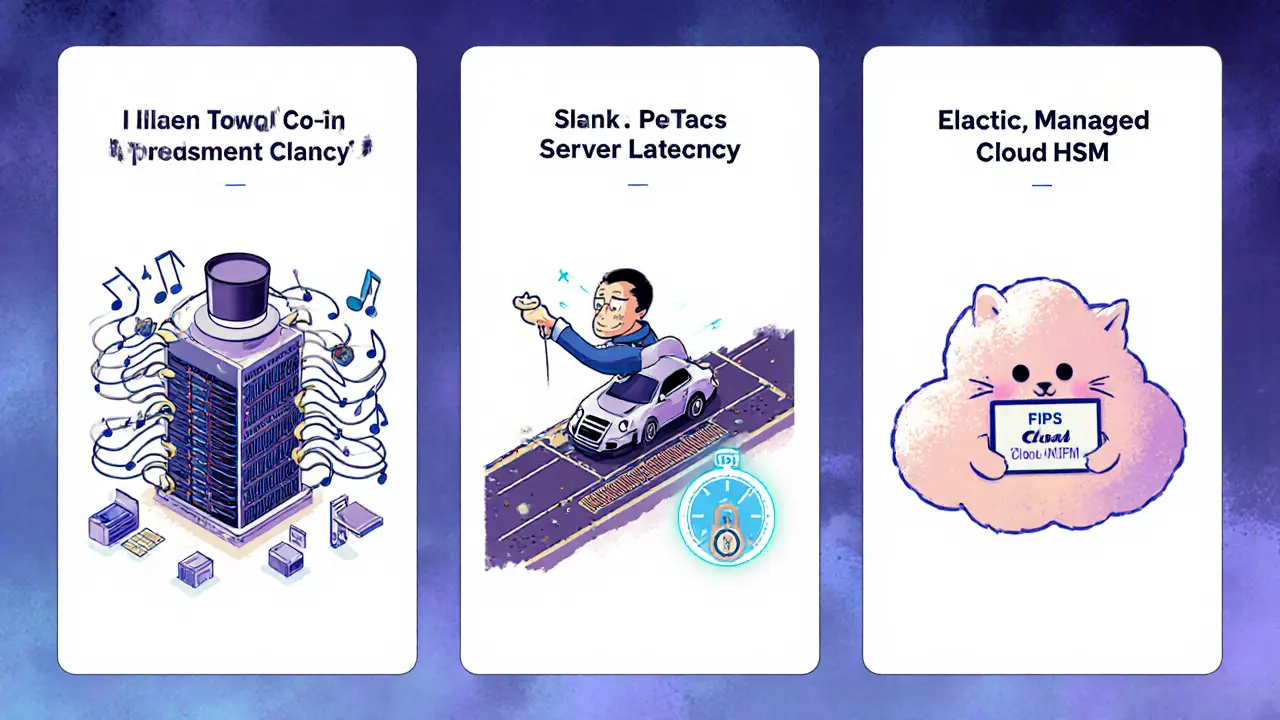HSM Deployment Model Selector
Recommended HSM Model
Why This Model?
HSM Deployment Models Overview
Network-Attached Appliance
Ideal for centralized policy enforcement and distributed environments.
PCIe Card
Best for ultra-low latency and direct server integration.
Cloud HSM
Perfect for startups and scalable, flexible deployments.
Key Takeaways
- Institutional‑grade HSMs keep cryptographic keys inside tamper‑proof hardware, meeting standards like FIPS 140‑2 Level 3.
- Three main deployment models exist: network‑attached appliances, PCIe cards, and cloud‑based HSM services.
- Choosing the right model depends on latency, compliance, existing infrastructure, and scalability needs.
- Implementation requires careful API selection (PKCS#11, KMIP, REST) and a solid key‑lifecycle plan.
- Future HSMs will add quantum‑resistant algorithms and deeper DevOps integration.
When organizations need iron‑clad protection for cryptographic keys, Hardware Security Module (HSM) is a tamper‑resistant device that generates, stores, and uses keys inside certified hardware, keeping them away from software attacks. Institutional‑grade solutions push this concept further with hardened enclosures, certified security levels, and built‑in acceleration for high‑volume workloads.
What Makes an HSM "Institutional Grade"?
Two certifications dominate the market: FIPS 140‑2 Level 3 and Common Criteria. Both require:
- Physical tamper evidence - the device erases keys if its enclosure is opened.
- Secure boot and a hardened operating system that never exposes raw keys.
- True Random Number Generators (TRNGs) that draw entropy from physical sources.
Meeting these standards signals that the HSM can survive sophisticated attacks while still delivering sub‑millisecond signing for transaction‑heavy environments.
Core Technical Features
Institutional‑grade HSMs share a handful of capabilities that set them apart from software‑only key stores.
- Key Generation Inside the Box - Keys are never exported in clear text; they are created by the internal TRNG and remain locked inside.
- Hardware Acceleration - Dedicated cryptographic engines handle RSA‑2048, ECC‑P‑256, AES‑256, and emerging post‑quantum algorithms at line‑rate speeds.
- Multi‑Layer Access Control - Role‑based policies, two‑factor authentication, and API‑key restrictions protect every operation.
- Standard API Support - Most HSMs expose PKCS#11, KMIP, and REST endpoints, making integration painless.
- Scalable Key Management - Centralized consoles let admins provision, rotate, and audit keys across dozens of devices from a single pane.

Deployment Models Compared
| Aspect | Network‑Attached Appliance | PCIe Card | Cloud HSM Service |
|---|---|---|---|
| Latency | Low‑to‑moderate (depends on network) | Ultra‑low (sub‑microsecond) | Variable - often comparable to network‑attached |
| Physical Control | Data‑center rack, limited remote access | Directly inside server chassis | Managed by cloud provider - no on‑prem hardware |
| Compliance Fit | Strong for PCI DSS, GDPR, HIPAA | Ideal when regulatory bodies demand on‑prem proof | Meets FIPS 140‑2 Level 3 in most major clouds |
| Scalability | Scale by adding more appliances | Scale by adding server slots | Elastic - spin up instances on demand |
| Operational Overhead | Medium - requires firmware updates, physical maintenance | High - hardware swaps, rack‑level planning | Low - provider handles patches and uptime |
Each model shines in specific scenarios. Financial firms that cannot tolerate any latency often embed PCIe cards. Global enterprises with distributed data centers may favor network‑attached appliances for centralized policy enforcement. Cloud‑native startups typically choose cloud HSMs to avoid CapEx and benefit from automatic scaling.
How to Choose the Right Model for Your Organization
Start with three questions:
- What is the maximum acceptable latency? If sub‑microsecond signing matters for high‑frequency trading, PCIe wins.
- Do regulations demand physical custody of the keys? Some government contracts stipulate on‑prem hardware, steering you toward network‑attached or PCIe.
- How quickly must you scale? Cloud HSMs let you add capacity with a few clicks, perfect for unpredictable workloads.
Map the answers onto a decision matrix, then verify that the vendor’s product supports the APIs your applications already use (e.g., PKCS#11 for legacy Java libraries or KMIP for modern key‑management platforms).
Implementation Best Practices
Even the toughest HSM won’t help if it’s misconfigured. Follow these steps:
- Define the key lifecycle - decide who can generate, rotate, and retire keys, and document the process in a policy.
- Integrate via standard APIs - use PKCS#11 for C/C++/Java, KMIP for cloud‑native services, or REST for modern microservices.
- Enable role‑based access control - limit key‑use to specific service accounts, enforce MFA for admin actions.
- Test tamper response - simulate a physical breach to confirm that keys are zeroed and alerts fire.
- Back up securely - use encrypted, air‑gapped backup modules that can restore keys only under multi‑person approval.
Most vendors provide a management console that shows audit logs in real time; integrate those logs with your SIEM to catch anomalies early.
Future Outlook: What’s Next for Institutional HSMs?
Two trends dominate the roadmap:
- Quantum‑resistant algorithms - NIST’s post‑quantum suite is already being trialed inside HSM firmware, ensuring long‑term data protection.
- DevOps‑friendly APIs - Vendors are adding CI/CD hooks that let you provision keys automatically during deployment pipelines.
Because the core premise-keeping keys inside tamper‑proof hardware-won’t change, the market will keep expanding as more industries (energy, telecom, IoT) adopt strict compliance regimes.

Frequently Asked Questions
What is the difference between a PCIe HSM and a network‑attached HSM?
PCIe HSMs sit inside a server’s expansion slot, giving the lowest possible latency because cryptographic operations happen on the same motherboard. Network‑attached HSMs sit in a rack and communicate over Ethernet, which adds network latency but lets many servers share a single key‑management point.
Can a cloud HSM meet FIPS 140‑2 Level 3 requirements?
Yes. Major cloud providers (AWS CloudHSM, Azure Dedicated HSM, Google Cloud HSM) run certified hardware inside their own data centers and expose the same FIPS‑validated cryptographic modules via API.
How does an HSM protect against insider threats?
Keys never leave the hardened module, and any attempt to open the enclosure triggers zeroisation. Combined with role‑based access and multi‑person approval for key export, insiders cannot simply copy a master key.
What APIs should I look for when evaluating HSM vendors?
At a minimum, support for PKCS#11 and KMIP is essential. If you run modern microservices, a RESTful API makes integration easier. Some vendors also expose SDKs for specific languages.
Is it worth the cost for a small company?
If you handle payment data, health records, or any regulated personal data, the compliance benefits often outweigh the expense. For startups with low‑risk data, a managed cloud HSM can provide a cost‑effective entry point.


Manish Gupta
October 3, 2025 AT 10:49olufunmi ajibade
October 3, 2025 AT 17:20Abby Gonzales Hoffman
October 4, 2025 AT 09:16And yes, cloud HSMs are legit. AWS CloudHSM runs actual FIPS 140-2 Level 3 hardware behind the scenes. No magic. Just physics and certification.
Cyndy Mcquiston
October 4, 2025 AT 13:33Prabhleen Bhatti
October 4, 2025 AT 20:48ashish ramani
October 5, 2025 AT 14:40Richard Williams
October 5, 2025 AT 21:09Sarah Hannay
October 6, 2025 AT 07:47Natasha Nelson
October 7, 2025 AT 06:05Joseph Eckelkamp
October 7, 2025 AT 19:11Elizabeth Mitchell
October 8, 2025 AT 10:36Chris Houser
October 8, 2025 AT 14:41Rampraveen Rani
October 8, 2025 AT 21:55John E Owren
October 9, 2025 AT 04:32Ashley Cecil
October 9, 2025 AT 21:57William Burns
October 10, 2025 AT 00:42Gabrielle Loeser
October 10, 2025 AT 12:08